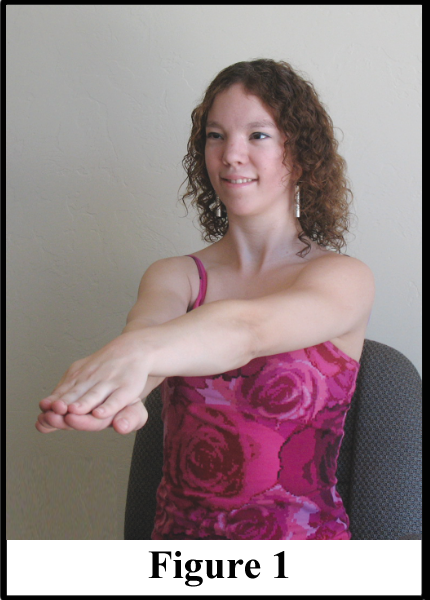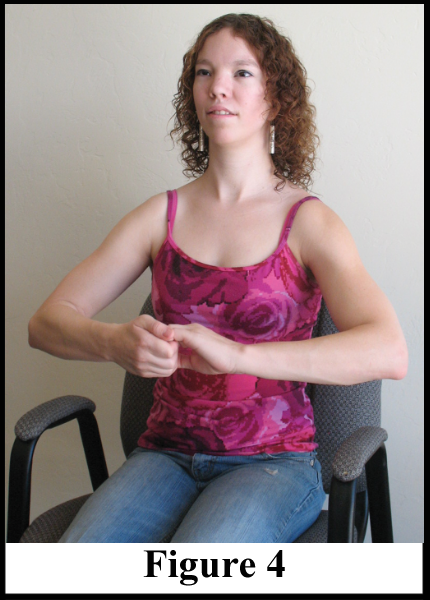Fibromyalgia Basics
Arm & Neck Exercises for Fibromyalgia
Home | Fibro Friendly Exercises
Getting your arms to look and feel stronger may be easier than you think. Ken Lamm, P.T., of Tucson, AZ, describes how arm and neck exercises for fibromyalgia can be done in only eight minutes per day without draining your energy. The key is isometric movements, which use a static or non-moving resistive force.
“The advantage of isometrics is there is no joint motion, so you are not grinding the joints that are already degenerating and it does not fatigue the muscles as much as the repetition-type exercises,” says Ken. “Isometrics cause controlled muscle contractions that build strength.” While this may not do much for endurance, “a six second contraction two times twice a day is equivalent to an hour of calisthenics.” These exercises can be done while waiting in rush-hour traffic, in your office chair, or during a commercial TV break.
Ken recommends with all these exercises “to start and stop slowly so that you are not jerking the joint and fast starting the muscle. Use your maximum exertion but do it while respecting pain because you should not have pain while performing these isometrics.” Initially try these exercises in front of a mirror until you get the hang of them. “Looking in a mirror will help ensure that you are not over-straining any muscles by hiking up your shoulders or slouching,” says Ken.
Research shows that isometrics are less likely to cause post-exercise pain in fibromyalgia patients.1 Still, you should perform the arm and neck exercises very gently until you know how your fibromyalgia muscles respond. Over time, strength training improves sleep and it also helps your nervous system function better to control pain.2,3
Hold the first ten exercises for six seconds, then switch positions. Repeat sequence one more time.
Arm Isometrics
To strengthen your fingers, wrists, and shoulders, extend your arms forward at shoulder height with one hand over the other. Keeping your arms straight, simultaneously push down with your top hand while pushing up with your bottom hand to produce a resistive force (Figure 1). “You will see that there is an overflow of action occurring with other muscles, particularly in the chest, neck and upper back.” So, this arm exercise also tones your neck and postural muscles, which is key for making it through the day with fibromyalgia.


Now, bend your elbows and make a fist with each hand. Pretend you are holding a baseball bat directly in front of you. Relax your neck, keep your shoulders even and your posture tall. Push down with the top fist while pushing up with the bottom one Figure 2). This particularly strengthens the biceps and triceps in your upper arms.


Keep your elbows bent, press your palms together. This will strengthen the muscles in your chest and arms (Figure 3). Next, hook your fingers together and try to pull your arms apart (Figure 4). This isometric is designed to tone the part of the arm that wiggles when you wave to someone, and it also strengthens the upper back muscles. If you have arthritis or sore hands, Ken recommends using other stationary objects instead of your hands. For example, stand tall with an elbow bent and press it into the wall (Figure 5). The wall will give the same resistive force as the hooked fingers.


Improving your grip and toning your forearm muscles can be done in a chair with armrests or using any pipe-shaped object. Sit in a chair and wrap your fingers around the vertical support below the armrest. Try to turn your palms upward and then downward (Figure 6). If you don’t have a chair with armrests or it’s just not convenient, you could use the steering wheel of a car while waiting at a stop light.
Using a pipe-shaped object, a second forearm isometric can be tried. Hold on to the piping and try to turn it as though you are wringing a towel. One hand will stop the other so the object doesn’t actually move (Figure 7).
Neck Strength
If you have been to the dentist lately, you probably noticed it was hard to lift your head up while in the reclined position. “Strengthening the neck and back muscles protects your vertebrae, giving you more stability and helping to reduce osteoporosis,” says Ken. These simple exercises strengthen your neck so your muscles can handle more of the wear and tear of daily life.
First, place the palms of your hands on your forehead. Then, while trying to keep your head still, push with your palms (Figure 8). This exercise strengthens the front neck muscles as well as the arms.
![]()
Now lock your fingers together and place them behind your head (Figure 9). “While keeping your locked hands still, press your head back into your hands, but make sure not to tilt your head up,” says Ken. This exercise is great for reducing weak shoulder and back of the neck muscles in fibromyalgia, while stretching your arms.
![]()
Place your hands on the sides of your head directly above the ears (Figure 10). This time, try to bend your head to your right ear and then the left ear while resisting the force with your hands. Then try to rotate your head from right to left, again resisting the force with your hands. For each of these neck exercises, Ken says, “aim for the motion but do not actually move the neck.”
![]()
Posture Correction
The last exercise strengthens your shoulders and upper back muscles to help prevent a forward shoulder posture (i.e., rounded shoulders). The upright posture exercises aid with neck rotation, breathing, and the ability to lift your arms out to the side. While sitting in a chair with your back supported, pull down and back with the shoulder blades. Push your elbows into the back of the chair while keeping your shoulders down (Figure 11). Try not to overuse your neck muscles during the exercise.
![]()
Timing
“It takes only three to four minutes to do all of the isometrics at once,” says Ken. “They are superb for strengthening the muscles without causing fatigue.” He recommends that each isometric be done twice a day … that’s only six to eight minutes out of your day, and you can do them throughout your day whenever you have a break.
“If you don’t use a muscle, you lose 17 percent of its strength each day,” says Ken. “That is why people who are hospitalized become so weak.” So even on a down day, Ken suggests that you try to perform these exercises at least once to keep your muscles toned and ready for tomorrow. Just remember to hold the first ten exercises for six seconds, then switch positions. Repeat sequence one more time.

Stay Current on Treatment & Research News: Sign up for a Free Membership today!
References for Arn & Neck Fibromyalgia Exercises
- Berardi G, et al. Phys Ther 102(6):pzad033, 2023. Free Report
- Cuenca-Martinez F, et al., Semin Arthritis Rheum 61:152216, 2023. Free Report
- Ellingson LD, et al. Brain Sci 6(1):8, 2016. Free Report
